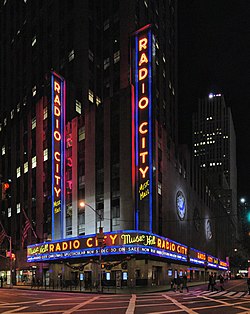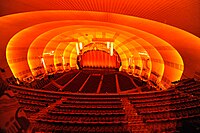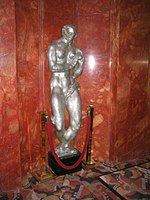I remember when this man named Dick Evans, who had run Disneyworld, was imported by the Rockefellers in the 1980's to try and stop the Music Hall from losing millions of dollars every years.
He fired a lot of inept creative types who had been putting on stage shows that kept the public away in droves and began making the hall operate more the way Carnegie Hall did...he turned the place around in less than a year
Here is a link to their website...go take a guided tour, it's worth it
http://www.radiocity.com/http://www.radiocity.com/
Radio City Music Hall
From Wikipedia, the free encyclopedia
 |
|
| Location | 1260 Avenue of the Americas (Sixth Avenue), Manhattan, New York City |
|---|---|
| Coordinates | 40°45′35″N 73°58′45″W |
| Type | Indoor theatre |
| Opened | December 27, 1932 |
| Owner | Tishman Speyer Properties (operated by The Madison Square Garden Company)[1] |
| Seating type | Reserved |
| Capacity | 5,933 / 6,015 |
Radio City Music Hall
|
|
| Area | 2 acres (0.8 ha) |
| Built | 1932 |
| Architectural style | Art Deco |
| Governing body | Private |
| Part of | Rockefeller Center (#87002591) |
| NRHP Reference # | 78001880[2] |
| Added to NRHP | May 8, 1978 |
Contents
History
The 12-acre (4.9 ha) complex in midtown Manhattan known as Rockefeller Center was developed between 1929 and 1940 by John D. Rockefeller, Jr., on land leased from Columbia University. The Radio City Music Hall was designed by architect Edward Durell Stone and interior designer Donald Deskey in the Art Deco style.Its originally planned name was International Music Hall.[3] The names "Radio City" and "Radio City Music Hall" derive from one of the complex's first tenants, the Radio Corporation of America. Radio City Music Hall was a project of Rockefeller; Samuel Roxy Rothafel, who previously opened the Roxy Theatre in 1927; and RCA chairman David Sarnoff. RCA had developed numerous studios for NBC at 30 Rockefeller Plaza, just to the south of the Music Hall, and the radio-TV complex that lent the Music Hall its name is still known as the NBC Radio City Studios.
The Music Hall opened to the public on December 27, 1932 with a lavish stage show featuring Ray Bolger, Doc Rockwell and Martha Graham. The opening was meant to be a return to high-class variety entertainment. The new format was not a success. The program was very long, and individual acts were lost in the cavernous hall. On January 11, 1933, the Music Hall converted to the then-familiar format of a feature film, with a spectacular stage show perfected by Rothafel at the Roxy Theatre in New York City. The first film was shown on the giant screen was Frank Capra's The Bitter Tea of General Yen, starring Barbara Stanwyck, and the Music Hall became the premiere showcase for films from the RKO-Radio Studio. The film-plus-stage-spectacle format continued at the Music Hall until 1979, with four complete performances presented every day.
By the 1970s, changes in film distribution made it difficult for Radio City to secure exclusive bookings of many films; furthermore, the theater preferred to show only G-rated movies, which further limited their film choices as the decade wore on.[4] Regular film showings at Radio City ended in 1979. Plans were made to convert the theater into office space, but a combination of preservation and commercial interests (including an irate commentary on Saturday Night Live's Weekend Update given by John Belushi) resulted in the preservation of Radio City and in 1980, after a renovation, it reopened to the public.
Radio City Music Hall is currently leased to and managed by The Madison Square Garden Company[5] Movie premieres and feature runs have occasionally taken place there such as the Harry Potter film series, but the focus of the theater throughout the year is now on concerts and live stage shows. The Radio City Christmas Spectacular continues to be an important annual event (see below). The Music Hall has presented most of the leading pop and rock performers of the last 30 years, as well as televised events including the Grammy Awards, the Tony Awards, the Daytime Emmy Awards the MTV Video Music Awards, and the NFL Draft. Starting in 2013, however, the Tony Awards will be the only major televised awards ceremony at Radio City, as the Video Music Awards relocated permanently to the Barclays Center that year. (The Grammys which alternated between New York City and Hollywood, has been held since 2004 in Los Angeles, as have the Daytime Emmys, off and on, since 2006.)
Design
Radio City has 5,933 seats for spectators, and additional seating can be placed on the pit elevator during events that do not require that space bringing the seating capacity to over 6,000; it became the largest movie theater in the world at the time of its opening.Designed by Edward Durell Stone, the interior of the theater with its austere Art Deco lines represented a break with the traditional ornate rococo ornament associated with movie palaces at the time. The radiating arches of the proscenium united the large auditorium, allowing a sense of intimacy as well as grandeur. The interior decor was created by designer Donald Deskey. Deskey's geometric Art Deco designs incorporate glass, aluminum, chrome, and leather in the ornament for the theater's wall coverings, carpet, light fixtures, and furniture. His work borrowed heavily from the European Modern aesthetic style, of which he was the foremost exponent in the United States.
The Great Stage, designed by Peter Clark, measures 66.5 by 144 ft (20.3 by 44 m), and resembles a setting sun.[6] Its system of elevators was so advanced that the U.S. Navy incorporated identical hydraulics in constructing World War II aircraft carriers; according to Radio City lore, during the war, government agents guarded the basement to assure the Navy's technological advantage.[7] This elevator system was also designed by Peter Clark, and was built by Otis Elevators.
Art
| This section does not cite any references or sources. (December 2013) |
Organ
The Music Hall's "Mighty Wurlitzer" pipe organ is the largest theater pipe organ built for a movie theater. Identical consoles with four manuals (keyboards) are installed on both sides of the Great Stage. Each console operates independently, with the one on the audience's left being the primary one of the two. The organ's 4,410 pipes are installed in chambers on either side of the proscenium's arch. Installed in 1932, the instrument was the largest produced by the Rudolph Wurlitzer Manufacturing Company of North Tonawanda, New York; it was built as a serious concert instrument rather than to accompany silent movies, capable of playing many styles of music including classical organ literature. A total rebuild of the historic organ was completed in time for the theater's restoration in 1999.[8] A smaller Wurlitzer organ was installed in the theater's radio studios, but was put into storage when the studio was converted into office space.Presentations and uses
Christmas show
Main article: Radio City Christmas Spectacular
The Radio City Christmas Spectacular is an annual Christmas stage musical produced by MSG Entertainment,
which operates the Music Hall. A New York Christmas tradition since
1933, it features the women's precision dance team known as The Rockettes.
Additional companies of Rockettes also tour every holiday season,
bringing the show to theaters around the country. In addition, the
program features appearances of Santa Claus.Cirque du Soleil: Zarkana
Main article: Zarkana
The Radio City Music Hall also hosted the Cirque du Soleil show
"Zarkana". It stopped playing on September 2, 2012 in order to prepare
for the 2012 Christmas Spectacular.Television
In November 1988, the theater played host to two weeks of Wheel of Fortune, which was taking its first road trip. Saturday Night Live announcer Don Pardo announced during the two weeks. The Mighty Wurlitzer organ (see above) was used to play the show's theme song, "Changing Keys", throughout each episode, except at the end. It played host to the show again in November 2003 for the nighttime show's 4,000th episode, and again in November 2007 for the nighttime show's 25th anniversary.It was also the site for Jeopardy!'s 4,000th episode as well as for its Million Dollar Masters invitational tournament in May 2002. It was used again in November 2006 for a 2-week Celebrity Jeopardy! event.
In 2013 the NBC summer reality talent show America's Got Talent was featured on the stage of the Music Hall for its live broadcasts for the show's eighth season starting July 23, 2013.










No comments:
Post a Comment
Please leave a comment-- or suggestions, particularly of topics and places you'd like to see covered